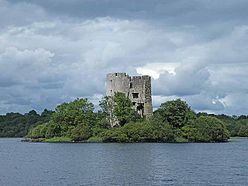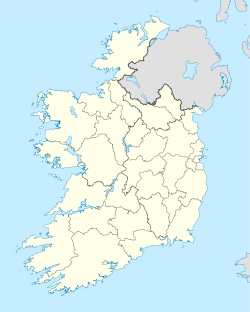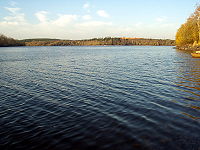- Cloughoughter Castle
-
Cloughoughter Castle 
Cloughoughter Castle sits on an island in Lough OughterGeneral information Location Lough Oughter, Cavan Country Ireland Coordinates 54°00′36″N 7°13′54″W / 54.0101°N 7.2318°W Construction started 1200 - 1224 Demolished 1653 Design and construction Client William Gorm de Lacy Reference #: 602 Cloughoughter Castle is a ruined circular castle, situated on a small island in Lough Oughter, 4 kilometres east of the town of Killeshandra in County Cavan, Ireland.
Contents
History
The castle is located in the historic Kingdom of Breifne, specifically in the part that would later be subdivided into East Breifne, roughly corresponding to County Cavan. Prior to the construction of the castle, the spot may have been a crannóg. In the latter part of the 12th century, it was under the control of the O'Rourkes, but it seems to have come into the hands of the Anglo-Norman William Gorm de Lacy after the Normans wrest control of some of the territory from that ruling clan. While the exact date construction began is unknown, it is estimated to have started in the first quarter of the 13th century. Architectural elements date the lower two storeys of cloughoughter to this time.[1]
In 1233, the O'Reilly clan took possession of the area and completed the castle. They retained it for centuries in the midst of their ongoing conflicts with the O'Rourkes and with members of their own clan. It was there that Philip O'Reilly was imprisoned in the 1360s with "no allowance save a sheaf of oats for day and night and a cup of water, so that he was compelled to drink his own urine."[1]
After the Plantations
For several decades, ownership of the castle changed hands when, after the 1607 Flight of the Earls Englishman Richard Wingfield seized possession and bestowed the lands on captain Hugh Culme during the Plantation of Ulster. Culme did not dwell in the castle, but built a new residence on the lake. The O'Reilly family regained control of the property during the Irish Rebellion of 1641, retaining it for a further 12 years. During this final phase of its active existence, it was used as a prison.[1] In this capacity, it held not only Captain Culme, who had evidently failed to defend it as he had been charged, but, notably, William Bedell, who died soon after his several weeks of imprisonment there evidently due to inadequate shelter from the cold winter.[2][3] The castle fell in the Cromwellian Invasion in March 1653, but not easily. Due to its location, Cromwell's forces were required to set up their cannons at considerable distance in the township of Innishconnel, which aided the castle's strong walls in withstanding the gunpowder for quite some time.[1][3]
Left in ruins, the castle became a frequent subject of art in the 18th and 19th centuries.[1] Its visual impact was described in a travelogue published The Dublin University Magazine in 1852:
It stands on a small island, scarce three hundred feet in diameter, just sufficient to contain the castle and a small margin of rock around it. The island stands in very deep water; the shores are a mile distant, wild, yet thickly wooded. The castle is a beautiful ruin, round, massive, hoary, save where mantled with rich Irish ivy. The walls are immensely thick, with embrasures and coved windows, round which "ruin greenly dwells." It is unlike most Irish castles, which are square.[4]
Conservation efforts were begun on the castle in 1987.[1][5]
References
- ^ a b c d e f [1] - Ireland's Eye.com, Cloughoughter Castle
- ^ McCullam, R. (1856). Sketches of the Highlands of Cavan, and of Shirley Castle, in Farney, taken during the Irish famine. J. Reed. p. 207. http://books.google.com/books?id=7z4NAAAAYAAJ&pg=PA207. Retrieved 29 March 2011.
- ^ a b Religious Tract Society (1885). The Sunday at Jome. Religious Tract Society. p. 747. http://books.google.com/books?id=tJ9HAAAAYAAJ&pg=PA747. Retrieved 29 March 2011.
- ^ Curry, William; Jun. & Co (1852). The Dublin University magazine. William Curry, Jun., and Co.. p. 519. http://books.google.com/books?id=n10ZAAAAYAAJ&pg=PA519. Retrieved 29 March 2011.
- ^ [2] - Explore Cavan, Cloughoughter
External links
National Monuments of Ireland By county Carlow • Cavan • Clare • Cork • Donegal • Dublin • Galway • Kerry • Kildare • Kilkenny • Laois • Leitrim • Limerick • Longford • Louth • Mayo • Meath • Monaghan • Offaly • Roscommon • Sligo • North Tipperary • South Tipperary • Waterford • Westmeath • Wexford • Wicklow
Categories:- Ruins in the Republic of Ireland
- National Monuments in County Cavan
- Castles in County Cavan
Wikimedia Foundation. 2010.



